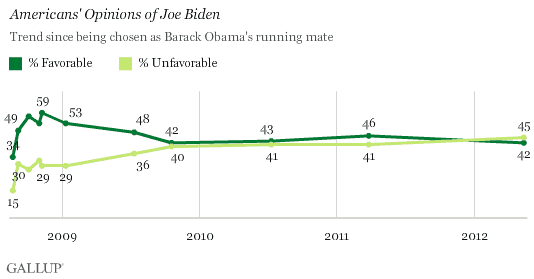PRINCETON, NJ -- Americans are about equally likely to have a favorable (42%) as an unfavorable (45%) view of Joe Biden, which has been the case for most of his tenure as U.S. vice president. Americans were much more positive than negative toward Biden from the time he was chosen as Barack Obama's running mate through the first several months of the Obama administration.

The May 10-13 USA Today/Gallup poll marks the first time opinions of Biden have tilted negative since he became Obama's vice presidential pick, but they are not materially different from the closely divided but still net positive ratings of Biden from October 2009-March 2011. The current poll was conducted after Biden's comments in favor of same-sex marriage on "Meet the Press" on Sunday, May 6 -- comments that led to President Obama's announcement that he too supported legalized same-sex marriage. The poll suggests those comments did not have a dramatic effect on how Americans view Biden.
Biden's favorable rating peaked at 59% immediately after the 2008 election. His current 45% unfavorable rating is his highest so far, though his unfavorable ratings have been at least 40% since October 2009.
Fourteen percent of Americans do not have an opinion of the vice president, similar to the levels Gallup has measured since October 2008.
Predictably, Democrats are overwhelmingly positive toward the Democratic vice president, and Republicans overwhelmingly negative. By 47% to 37%, independents are more negative than positive.

When Gallup last measured opinions about Biden, in March 2011, Democrats' and independents' views were essentially the same as they are now. Republicans were a bit more positive toward him at that time, with 24% favorable and 68% unfavorable ratings.
Implications
Americans' views of Vice President Biden have not changed much in over two years, with similar proportions having positive or negative views of him since October 2009.
That roughly equal division of opinion makes him slightly less popular than the president, who has a 52% favorable and a 46% unfavorable rating in the same May 10-13 poll. Biden is much less popular than Secretary of State Hillary Clinton, who was also considered for the vice presidential slot and, like Biden, was one of Obama's challengers for the 2008 Democratic presidential nomination.
Given the partisan division of opinion about Biden, he may be best suited to energize the Democratic base rather than trying to attract independent support to the Obama campaign this election year.
Survey Methods
Results for this USA Today/Gallup poll are based on telephone interviews conducted May 10-13, 2012, with a random sample of 1,012 adults, aged 18 and older, living in all 50 U.S. states and the District of Columbia.
For results based on the total sample of national adults, one can say with 95% confidence that the maximum margin of sampling error is ±4 percentage points.
Interviews are conducted with respondents on landline telephones and cellular phones, with interviews conducted in Spanish for respondents who are primarily Spanish-speaking. Each sample includes a minimum quota of 400 cell phone respondents and 600 landline respondents per 1,000 national adults, with additional minimum quotas among landline respondents by region. Landline telephone numbers are chosen at random among listed telephone numbers. Cell phone numbers are selected using random-digit-dial methods. Landline respondents are chosen at random within each household on the basis of which member had the most recent birthday.
Samples are weighted by gender, age, race, Hispanic ethnicity, education, region, adults in the household, and phone status (cell phone only/landline only/both, cell phone mostly, and having an unlisted landline number). Demographic weighting targets are based on the March 2011 Current Population Survey figures for the aged 18 and older non-institutionalized population living in U.S. telephone households. All reported margins of sampling error include the computed design effects for weighting and sample design.
In addition to sampling error, question wording and practical difficulties in conducting surveys can introduce error or bias into the findings of public opinion polls.
View methodology, full question results, and trend data.
For more details on Gallup's polling methodology, visit www.gallup.com.
